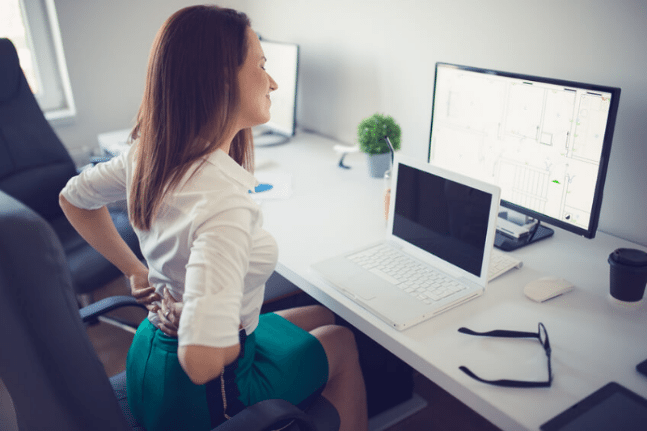How can you stop stiffness?
Stiffness is something that many people complain about. Stiffness can be a sensation (like a “pulling” or a “tightness”), or it can be a reduction in movement (i.e. being unable to twist left to right etc).
We’re not entirely sure what causes “stiffness”, because it is difficult to define. Your version of stiffness might be different to mine, and could be caused by different things.
We know that the uncomfortable sensation that comes with sitting for too long is just a mild version of pain, which I explained in my last post. As such, the discomfort that we feel is a sensation that our brain creates to try and make us move!
So, how can you prevent that yucky, stiff feeling that hits you after a couple of hours at your desk?
1. Move!
I know that I sound like a broken record on this blog when I include that old movement chestnut, but it’s by far the easiest, cheapest and most effective way of combating discomfort that arises from sitting all day. A colleague of mine, Dr Bill Adamson (osteopath), recently wrote a blog about how sitting is not the new smoking but alludes to inactivity still being really bad for us. I concur.
So, how can you move more? I have written a post on that very topic. Otherwise, the easiest way is to set a timer for every 30 minutes; get up, have a stretch, walk to the water cooler and by the time you’ve sat down again you’ll feel much better.
Good exercises to use at your desk:
- Shoulder rolls: squeeze ’em up, roll ’em back, drop ’em down. Repeat four times.
- Neck stretches: gently hold the top of your head with one hand, and pull towards your shoulder (GENTLY!). Hold for 20 seconds to feel a comfortable stretch. Repeat on the other side.
- Thoracic rotations: put your arms across your chest, then twist your body left and right 10 times each.
2. Sit-to-stand desks.
If your workplace has the option of installing a sit-to-stand desk, why not take the opportunity?
Sit-to-stand desks are adjustable desks that can be used at either sitting or standing height.
I usually recommend my patients who use them to swap three times a day; so spend the morning sitting, late morning standing, after lunch sitting and end of day standing. This way they are changing their position across the day and not allowing muscle fatigue to creep in.
3. Keeping your stress in check.
Are you under the pump? Bogged down with mountains of work? Tearing your hair out?
We live in a really busy world and a lot of people are in positions at work where they’re under immense pressure to perform.
Often, this stress will spill over into physical manifestations. Why not check now? Are you clenching your jaw? Scrunching your shoulders up? Squinting your eyes?
We live in a really busy world and a lot of people are in positions at work where they're under immense pressure to perform.
Stress can affect our office discomfort in many ways. One of them is the physical “overuse” that certain muscles suffer as a result of clenching them (such as our jaws). This is an inbuilt defence mechanism of our bodies when we’re stressed, from when we used to need to be on “high alert” with blood pumping and muscles clenched in order to run away from predators.
The other way that stress can influence our discomfort is by amplifying our pain.
We know that pain is never an accurate gauge of damage, so the discomfort can come about for other reasons as explained in my last blog.
If you’re highly stressed, try to take some deep breaths while counting to eight. Exhale for eight as well. Repeat three to four times. Exercise is also a great stress buster, so try a good walk.
If you’re really struggling to get on top of things, psychologists are worth their weight in gold. For anyone out there who is rolling their eyes at the prospect of “seeing a shrink”, I can assure you that your impression of psychologists is wrong.
A good psychologist will act as an ear to complain to but, more importantly, help you come up with some coping strategies to reduce your mind and body’s response to stress. They’re superstars.
Keep well,
Claire










